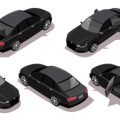Introduction to Road Sign Recognition
In recent years, road sign recognition technology has started to play a big role in the way Americans drive. As more vehicles on U.S. roads become equipped with advanced driver-assistance systems (ADAS), understanding and responding to traffic signs is no longer just up to the human behind the wheel. Road sign recognition uses cameras and artificial intelligence to detect and interpret signs like speed limits, stop signs, and school zones in real time. This technology then alerts drivers or even adjusts vehicle settings automatically, making driving safer and less stressful. With distracted driving and busy highways becoming bigger concerns across the country, having an extra set of eyes on the road is quickly turning from a luxury into a necessity for American drivers.
2. How Road Sign Recognition Works
Road sign recognition is a cutting-edge technology that’s making American roads safer and smarter. At its core, this system uses a combination of advanced sensors and artificial intelligence (AI) to “read” road signs just like a human would—but with the added benefit of never getting tired or distracted. Here’s a practical breakdown of how it all comes together, using scenarios familiar to any driver in the U.S.
The Technology Behind the Scenes
Modern vehicles equipped with road sign recognition rely on a blend of cameras, radar, and sometimes lidar sensors. These devices constantly scan the environment for road signs such as speed limits, stop signs, yield signs, and more. Once a sign is detected, AI-powered software analyzes the image, recognizes the type of sign, and interprets its meaning for the driver. The information is then displayed on the car’s dashboard or heads-up display, giving real-time feedback.
Common Sensors and Their Roles
| Sensor Type | Main Function | Example Scenario (U.S.) |
|---|---|---|
| Camera | Captures images of road signs and surroundings | Spotting a “Speed Limit 55” sign on an interstate highway |
| Radar/Lidar | Measures distance and position of objects (including signs) | Detecting a stop sign at a rural intersection through fog or heavy rain |
| GPS & Map Data | Provides location context to confirm sign relevance | Verifying if a school zone speed limit applies based on time and location |
Real-Life Example: Navigating an American Suburb
Imagine you’re driving through a typical American suburb. As you approach a four-way stop, your vehicle’s camera picks up the red octagonal shape of a stop sign. The AI recognizes it instantly and flashes a reminder on your dashboard. A few blocks later, you pass by a “Children at Play” sign—your car alerts you to slow down, even if you missed seeing it yourself. This tech doesn’t just spot obvious signs; it also helps interpret temporary signs in construction zones or adjust for changing speed limits in school zones.
Why It Matters for Everyday Drivers
This seamless interaction between sensors and AI means drivers get timely reminders about crucial road rules—helping everyone stay alert, avoid fines, and drive safely no matter where they are in America.
![]()
3. Boosting Driver Awareness and Safety
Recognizing essential road signs—like speed limits, stop signs, and school zone alerts—is a game changer for driver awareness and safety on American roads. When drivers spot these signs in real-time, whether through their own observation or with the help of modern road sign recognition technology, their reaction times improve significantly. For example, noticing a speed limit sign just before entering a new area helps drivers adjust their speed instantly, reducing the risk of speeding tickets or dangerous accidents. Stop signs require drivers to come to a full halt, and being alert to them ahead of time ensures intersections are navigated safely. School zones are another critical area; when drivers see those distinctive signs, theyre reminded to slow down and watch for children crossing. In all these cases, quick recognition leads to faster decision-making behind the wheel. This heightened awareness not only protects the driver but also everyone else sharing the road—from pedestrians to cyclists and other motorists. By making it easier to notice and respond to important traffic signs, road sign recognition systems help create safer streets and reinforce good driving habits every day.
Integration With Modern Vehicles
Today, road sign recognition isn’t just a futuristic concept—it’s a standard feature in many popular car models across the U.S. market. Leading automakers like Ford, Toyota, BMW, and Tesla have incorporated this technology to help drivers stay aware of important traffic signs such as speed limits, stop signs, and no-entry zones. The process uses forward-facing cameras and advanced image processing algorithms to detect and interpret road signs in real time.
Here’s a quick look at how some top car brands integrate road sign recognition and how you’ll typically interact with it:
| Brand | Model Examples | How Drivers Interact |
|---|---|---|
| Ford | F-150, Explorer, Mustang Mach-E | Displays detected signs on the dashboard cluster; may alert if exceeding speed limit |
| Toyota | Camry, RAV4, Highlander | Shows signs on the digital instrument panel; audible warnings for ignored stop or yield signs |
| BMW | X5, 3 Series, i4 | Presents sign information in the head-up display; visual reminders for speed changes |
| Tesla | Model 3, Model Y, Model S | Sends visual cues on touchscreen; integrates with Autopilot for speed adjustment |
This seamless integration means most drivers don’t need to do anything special—just keep their eyes on the road and pay attention to alerts or icons appearing on their dash or heads-up displays. For example, when you’re driving a Toyota RAV4 down an unfamiliar highway, if the system spots a new speed limit sign or an upcoming school zone, you’ll get an instant heads-up right where you’re already looking. In high-end vehicles like BMWs or Teslas, these cues blend into your overall driving experience without becoming distracting.
The result? Drivers are less likely to miss crucial road signs—even in heavy traffic or poor weather conditions—making every trip safer and less stressful. As more automakers adopt and refine this tech, road sign recognition is quickly becoming a must-have feature for safety-minded American drivers.
5. Impact on American Roads and Communities
Across the United States, road sign recognition technology is making a visible difference in driver awareness and overall safety. In bustling cities like New York and Los Angeles, where traffic signs are abundant and distractions are everywhere, advanced driver-assist systems help drivers notice and respond to speed limits, stop signs, and crosswalk warnings more reliably. For example, recent city pilot programs have reported fewer red-light violations and better compliance with variable speed zones, reducing accidents at busy intersections.
Meanwhile, on rural highways stretching through states like Texas or Montana, where long stretches can make it easy to miss a key warning sign, this technology steps in as an extra set of eyes. When drivers might be fatigued or distracted by scenic views, road sign recognition systems alert them to upcoming sharp turns, animal crossings, or changes in speed limits—helping prevent high-speed incidents that are all too common on these roads.
Community feedback from suburban neighborhoods has also been positive. Parents appreciate that these systems catch school zone signs even when visibility is low due to weather or parked vehicles. This added layer of awareness helps protect children during busy drop-off and pick-up times.
Law enforcement agencies have noticed the benefits as well. In areas where local governments have invested in smarter infrastructure and encouraged car owners to use vehicles equipped with road sign recognition features, there’s been a measurable drop in speeding tickets and accident rates. These improvements save lives but also reduce insurance premiums and municipal costs related to traffic incidents.
From coast to coast—whether it’s supporting safe navigation through complex city grids or reminding drivers of important rules on quiet backroads—road sign recognition is quietly transforming how Americans experience their daily commutes. The result is safer streets for everyone: pedestrians, cyclists, and drivers alike.
6. Tips for Making the Most of Road Sign Recognition
Road sign recognition technology is a fantastic tool, but it works best when drivers use it wisely and stay actively engaged on the road. Here are some practical tips to help you get the most out of this feature while maintaining top-notch driver awareness:
Stay Alert and Don’t Rely Completely on Technology
While road sign recognition can catch important signs you might miss, it’s not perfect. Weather conditions, dirty windshields, or damaged signs can affect its accuracy. Always keep your eyes on the road and double-check with your own observations.
Familiarize Yourself with System Alerts
Take time to understand how your car’s system communicates detected signs—whether it’s through dashboard notifications, audio alerts, or visual cues on your display. Knowing these signals helps you respond quickly and appropriately.
Use It as a Backup, Not a Substitute
Think of road sign recognition as an extra set of eyes, not a replacement for your judgment. Use it to reinforce what you already know about local speed limits and traffic rules, especially in unfamiliar areas or during long drives.
Keep Your Camera and Sensors Clean
For the system to work effectively, make sure the sensors and cameras (usually located near the windshield) are clean and unobstructed. Regularly check for dirt, snow, or leaves that could block their view.
Stay Up-to-Date with Software Updates
Manufacturers often release updates to improve detection accuracy and add new features. Check for updates during routine maintenance or through your vehicle’s infotainment system if available.
Always Practice Safe Driving Habits
No technology can replace attentive driving. Avoid distractions, stay focused, and remember that you’re responsible for all decisions behind the wheel—even when using advanced driver assistance systems like road sign recognition.
By combining the strengths of road sign recognition technology with your own alertness and good driving habits, you’ll enjoy safer journeys and make smarter decisions wherever the road takes you.


